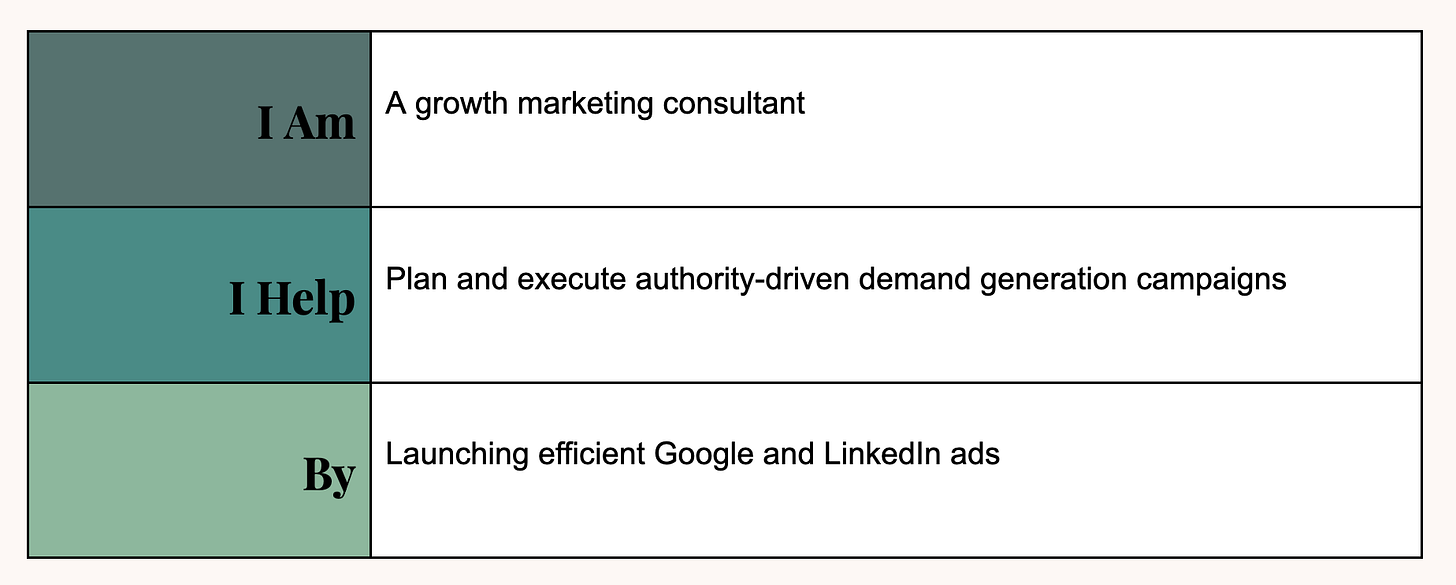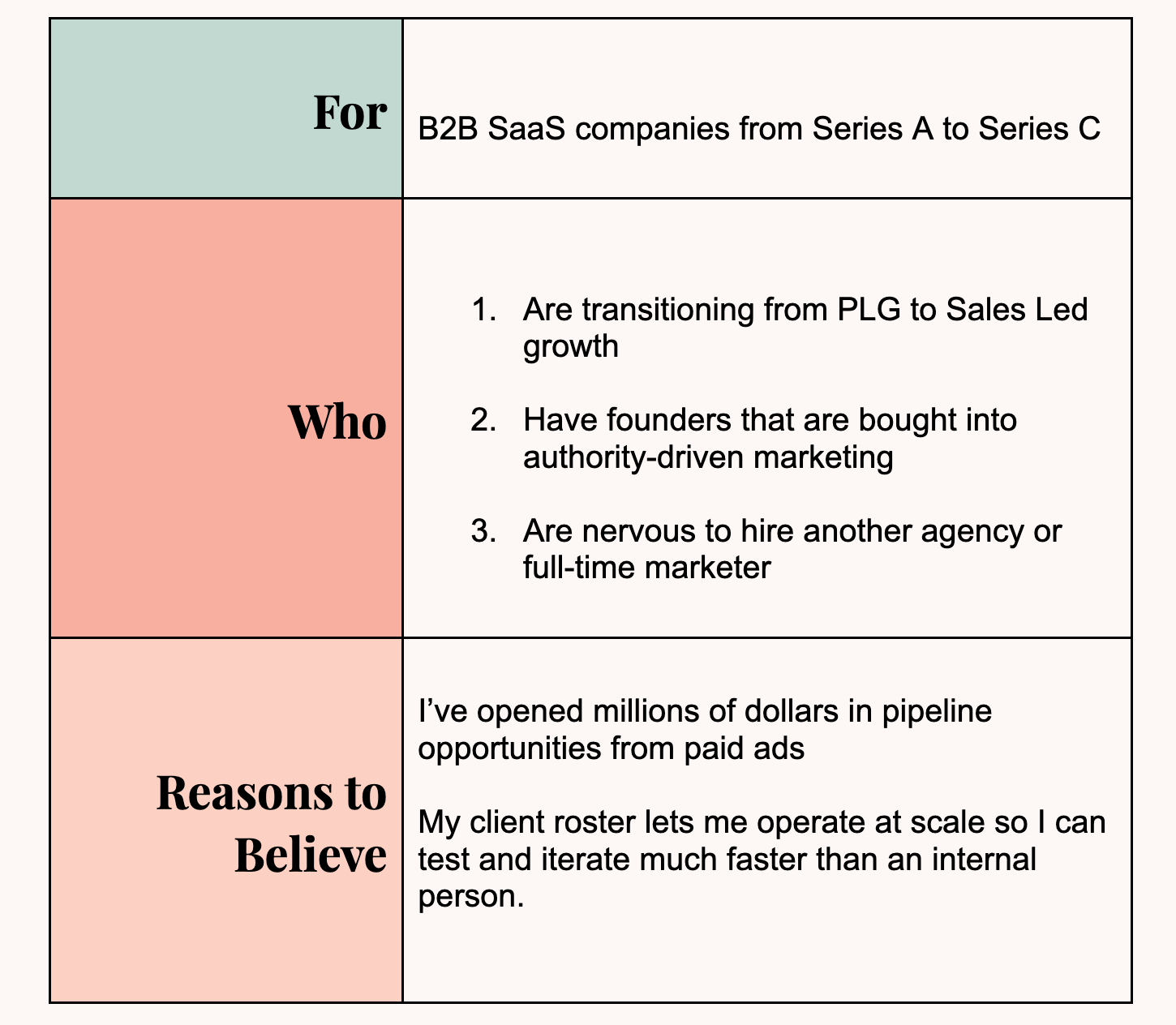Early Exit #29: A Masterclass on Personal Positioning
Want to raise your prices? Tighten up your positioning first.
You’re reading Early Exit Club — a newsletter about leaving the 9-5 workforce to build a $20k/month solo business by Nick Lafferty.
Last time: How to negotiate your rates
Next time: January finance update (spoiler: 📉)
There is nothing more important to a freelancer or marketing agency than how you position yourself.
Your pricing structure is worthless if prospective clients don’t understand the true value you bring.
And your perceived value is directly tied to your positioning, which I define as what you do and who you do it for.
Billion dollar companies like Loom hire teams of people to define and update their positioning. Positioning dictates everything from what copy you use on your homepage, to how you craft your sales deck, to how you talk about your competitors.
These positioning experts are called Product Marketing Managers(PMMs) and their entire job is to deeply understand a product’s value and the types of customers it serves.
PMMs build and apply frameworks to help evaluate and position the companies they work for, and these frameworks can also be applied to your freelancing business or marketing agency.
I sat down with an award winning PMM leader to help redefine my positioning as a freelancer and to teach you how to redefine yours.
Meet Tamara Grominsky
Tamara is the founder of PMM Camp, a community for experienced PMMs looking to build connection with their peers and grow their careers. Tamara previously was the VP of Product Marketing at Kajabi (valued over $2 billion) and Chief Strategy Officer at Unbounce.
She recently launched a free Personal Positioning Framework course designed for PMMs to better help them define and bring their unique value to life.
But anyone can benefit from better positioning, so we sat down to apply her framework to my freelancing business. This newsletter will show how we did it and how you can apply it to your business too.
Why does this matter?
It is impossible to scale your freelancing business to $30,000+ a month without a clearly defined position of what you do (and what you don’t do) and who you do it for (and who you can’t help).
Otherwise you’ll say yes to every type of work that comes your way and find yourself doing all kinds of random bullshit that you’re not really that good at (ask me how I know this).
Your positioning is a filter to help you focus only on the best fit customers.
Your best fit customers are ones where you’re 100% confident you can knock it out of the park. Because if you know with absolute certainty that you can do that, then you can also:
Command a higher price for your services (because you’re really good at this)
Build high amounts of trust with them (so they listen to your recommendations)
Ask them for a case study (to build an unstoppable referral engine of business)
So here’s how you can craft your positioning to get more of the right clients who will gladly pay higher rates for your services.
Step 1) Define your value
What are you uniquely qualified to do?
Tamara recommends a few prompts to get your thoughts organized:
What types of projects do you have an outsized impact on?
What projects and tasks give you energy? Which ones drain you?
What are the core strengths and values you lean on to complete any task?
Here’s an example from my business.
My example: a growth marketing consultant
Early on I positioned myself as a very broad growth expert and as a result I had a clients across too many types of projects. Initially it was great, I had money coming in the door!
But eventually I found that I didn’t like consulting in many of those areas. And the context switching between SEO and Paid Ads work was really draining for me.
Here are my specific answers to Tamara’s questions:
What types of projects do you have an outsized impact on?
I’ve driven the best results by managing, optimizing, and growing paid ads campaigns to continually hit quarterly targets.
What projects and tasks give you energy? Which ones drain you?
Running an SEO and content strategy is draining for me when I also need to context switch into other work. Paid ads work is fun and energizing.
What are the core strengths and values you lean on to complete any task?
I am very technical and good at quickly iterating on small changes to make big gains over a short period of time.
So I stopped taking new SEO clients and now I only focus on running paid ads, specific to Google and LinkedIn.
Here’s a much tighter definition of my freelancing business right now.

But who cares?
Step 2) Identify who cares
Once you’ve identified what you do, it’s time to focus on who you do it for.
This part was easier for me, because the companies I help also match the types of companies I’ve spent my entire career working for: Early to growth stage companies, typically from Series A to Series C.
Tamara recommends thinking about:
Your ideal vertical or industry (SaaS? Fintech?)
Customer type (Startups? Fortune 500?)
Go-to-market motion (PLG? Sales led? Hybrid?)
Growth stage (Seed? Series C?)
My Example
A surprising number of my current clients are transitioning from PLG into more of a Sales Led strategy, so including that in my positioning made sense.
I’ve also noticed a huge difference in success with paid ads (particularly on LinkedIn) where the founders are bought into the idea of social selling and building authority. Anyone who isn’t bought into that vision isn’t a good fit for me right now.
My 10-year career is built on the success I’ve had with paid ads, but more recently I’ve found that managing multiple ad accounts helps me test different ideas and get feedback much faster. Then I can pattern match winning strategies across all of my clients.
Lastly, almost all of my deals are with clients who have been burned by bad marketing agencies in the past and/or reduced the size of their marketing team within the last year.
All of these ideas went into crafting the below image.

Go apply this framework to your business
These are just examples from my business. I guarantee your business could use a tune-up when it comes to positioning.
When you’re done, use your framework to rewrite your website, your LinkedIn profile, and your pitch decks.
Your positioning isn’t set in stone, plan to revisit this every 9-12 months to see if anything has changed.
Take an hour this weekend to go through Tamara’s course so you can start 2024 off with a bang.
It’s 100% free — what do you have to lose?
A sincere thank you to Tamara for generously lending me her time and experience. Any PMMs who are subscribed to her newsletter can look out for some reciprocal advice from me in the future on how they can take their personal positioning and catapult it into a thriving freelancing business.
See you all next week for my monthly finance update!
Nick
Did someone send this to you? First, tell them thanks. Second, maybe you should subscribe too?






Thanks for this, Nick! Looking forward to your results with those adjustments!
I’ve been going through a similar exercise so it’s great to see I’m mostly in the right direction with a few tweaks needed.
It definitely helps clarifying your positioning. Thanks for sharing your story and the resources!